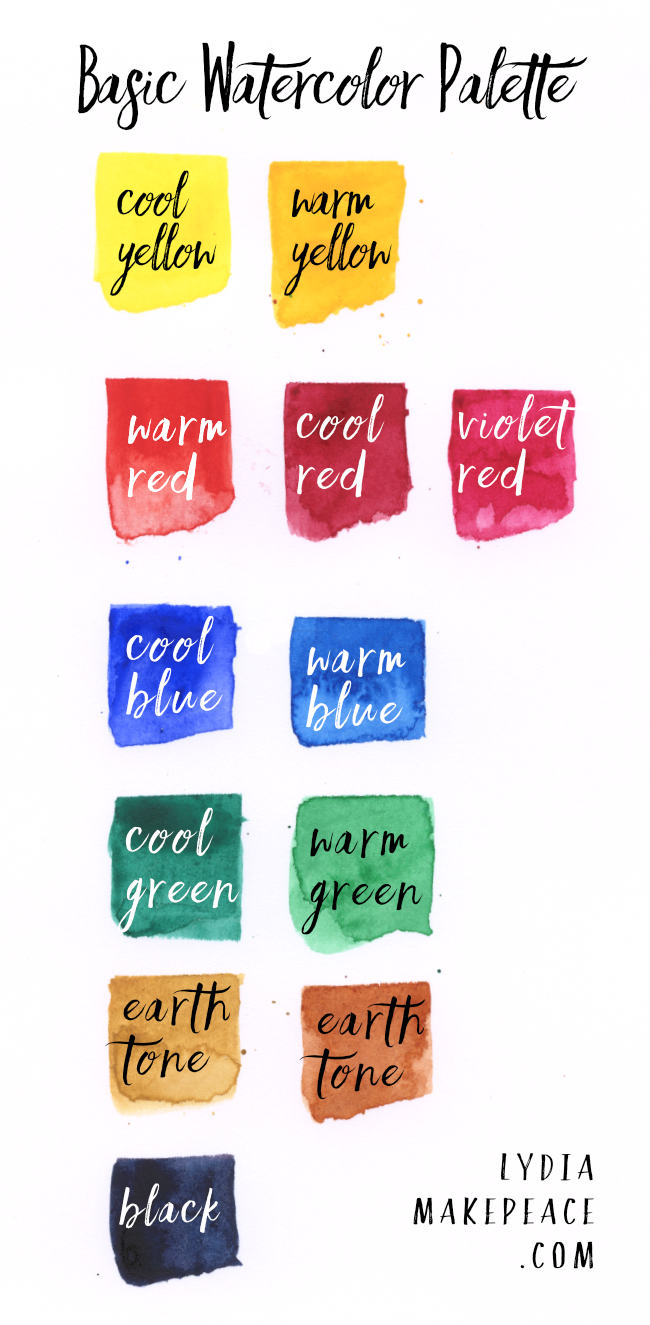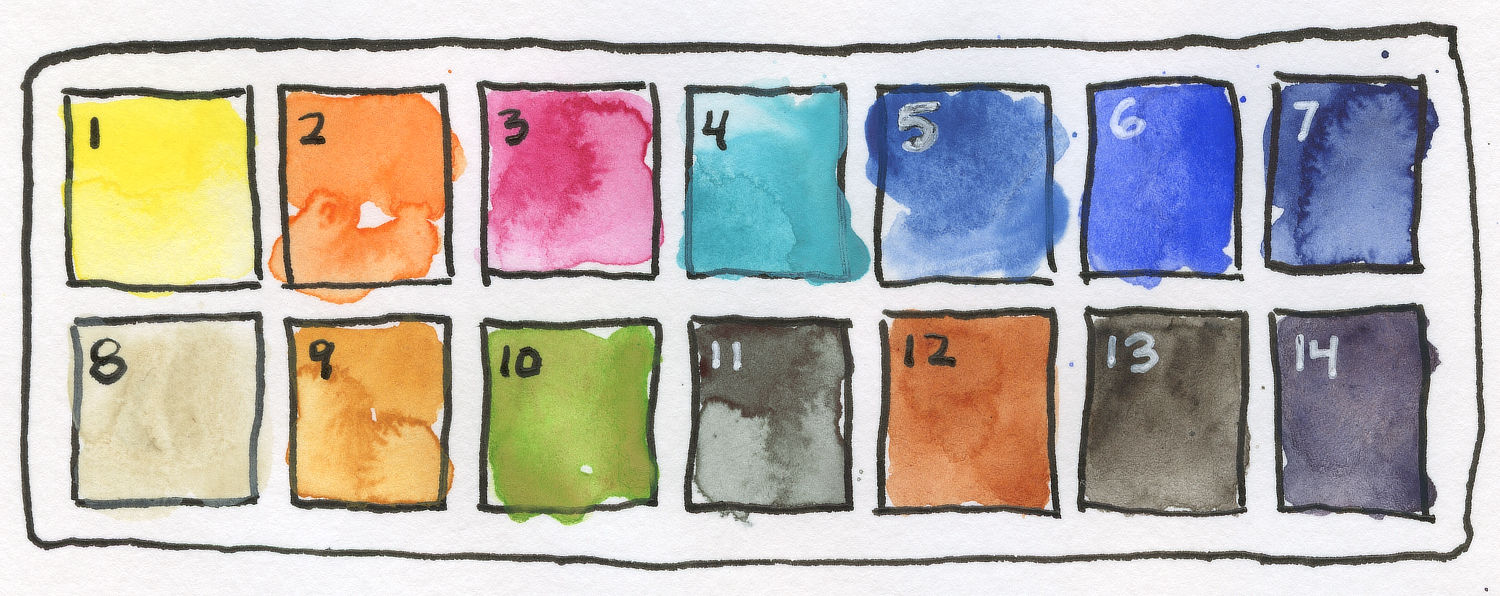Basic Watercolor Palette: 12 essential colors
Updated 9.23.18
Whether you're purchasing your first set of watercolor paints or looking to upgrade to professional quality pigments, selecting colors for even the most basic watercolor palette can easily become a daunting task when faced with the sheer number of colors and paint brands. The good news is that I’ve put together the following comprehensive guide to help assist in the selection process. Welcome to the vibrantly wonderful world of watercolor!
What's in my paint and why do I need to know?
Because color names are not consistent from brand to brand it’s not possible to simply provide a suggested list of colors. Instead you’ll need to learn a little bit about what’s in watercolor paint and how it’s labeled.
Watercolor paint is made from a combination of natural or synthetic pigments, gum arabic, additives, and water. Pigment consists of small particles that give watercolor paint its color. Gum arabic is used as a binder to hold the pigment particles together and help the paint adhere to paper. Various additives such as glycerin, ox gall, or honey are used to alter the handling properties of the paint.
Because paint color is determined by pigment it’s important to know which pigments are in your paint. As I mentioned above color names are NOT consistent from brand to brand which is why you must look for something called the Color Index Name.
A Color Index what?! That sounds complicated...
The Color Index is a universal system that assigns a unique alphanumeric code to each pigment used in art supplies. For example: PB29, which stands for Pigment Blue 29, commonly known as Ultramarine Blue.
Here’s where the Color Index Name is located on my Winsor and Newton watercolor paint tube.
Additional examples of commonly used pigments -
PR108 - Pigment Red 108, commonly known as Cadmium Red
PY43 - Pigment Yellow 43, commonly known as Yellow Ochre
PG7 - Pigment Green 7, commonly known as Phthalo Green Blue Shade
You may have noticed a pattern in the Color Index Names. The P is for Pigment and the following letter corresponds to a basic pigment color category.
Common Pigment Codes
PY - Pigment Yellow
PO - Pigment Orange
PR - Pigment Red
PV - Pigment Violet
PB - Pigment Blue
PG - Pigment Green
PBr - Pigment Brown
PBk - Pigment Black
PW - Pigment White
Most reputable artist quality brands will display the Color Index Name somewhere on the paint label, albeit in small print. Get ready to pull out a magnifying glass!*
* For those without a magnifying glass some paint brands, such as Winsor and Newton and M. Graham , provide a handy chart with Color Index Names online.
How many colors do I need?
When you’re just starting out as a painter it’s tempting to purchase as many colors as possible. (This isn’t helped by the fact that there are so many “beginner paint kits” offering 50 plus colors!) In reality, relatively few colors are actually needed to make a painting. In fact, most experienced painters use a small basic palette plus a few personal favorites.
Theoretically you only need the three primary colors - yellow, red, blue - to create all the other colors of the rainbow. Whilst this can be a useful palette for learning color theory it is of limited use for everyday painting because of the time required to mix colors and difficulty in creating certain hues. For this reason many painters use a basic 12 color watercolor palette.
Which colors should I buy?
The 12 color watercolor palette commonly consists of the following: warm and cool versions of the three primary colors (yellow, red, blue), violet red, a warm and a cool green, two earth tones, and a black or neutral grey. Don’t think of this palette as set in stone though. Some artists (myself included) prefer to mix their own black and choose to replace it with another color. Additionally you’ll notice that white is missing from the basic palette. This is because traditional transparent watercolor technique uses the white of the paper rather than a white pigment. (It's not "wrong" to use white paint, just a different technique better left discussed in a separate post.)
I love this post by Parka Blogs featuring the basic 12 color palettes of 6 different artists.
Basic Winsor & Newton Watercolor Set
Yellows
Winsor Yellow PY154
Winsor Yellow Deep PY65
Reds
Permanent Rose PV19
Cadmium Red PR108
Permanent Alizarin Crimson PR206
Blues
French Ultramarine PB29
Winsor Blue Green Shade PB15
Cerulean Blue PB35
Greens
Winsor Green Yellow Shade PG36
Winsor Green Blue Shade PG7
Earth Colors
Yellow Ochre PY43
Burnt Sienna PR101
Dick Blick is my art supplier of choice. They offer affordable pricing, excellent customer service and quick delivery.
What's the difference between artist quality and student grade watercolor paint?
Artist quality paints generally contain higher quality, single pigment compositions (resulting in more vibrant colors) at a greater concentration and higher permanence rating. Student grade paints may use a combination of inferior pigments that contain fillers and extenders. Whichever paints you use, be sure to check for the ASTM lightfastness rating to ensure color durability when exposed to light.
Creating Your Own Personal Palette
As you gain experience you’ll discover your own basic palette preferences. Remember, there is no one right color palette for everyone. Hopefully this guide has provided you with a good place to start!
Extra Credit
For a truly exhaustive and indispensable guide to watercolor paint and pigments be sure to check out the Handprint website.
What's your preferred palette? I’d love to hear about your favorite colors in the comments below.














